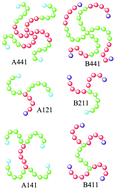Mesoscopic simulation of the self-assembly of the weak polyelectrolyte poly(ethylene oxide)-block-poly(methyl methacrylate) diblock copolymers
Abstract
We designed twelve types of weak polyelectrolytes (i.e., PEO-b-PMMA copolymers (BCP) in multi-arm structures, where six include EO blocks as joint points and the other six have MMA blocks as joint points). All of the BCPs with EO as the joint points form disordered phases with the exception of long-chained and four-armed BCP. The main mesophases of all of the BCPs with MMA as joint points are micelle-like and bicontinuous phases. In particular, the short-chained BCP with four-arms and EO segments outside form a new phase type (i.e., crossed lamellar phase). Using MesoDyn, we provide a comprehensive representation of the micelle and crossed lamellar phase formation mechanisms based on both thermodynamic and dynamic analyses. A shear force on a micelle-like phase could promote a hexagonal columnar phase, which is a good technique for generating an ordered arrangement of nanotube arrays. Blending homopolymers with the same constituents could promote uniformity of the micelle size and decrease the polydispersity, especially for blends with a high BCP concentration, which may provide a new approach for regulating the properties of materials.


 Please wait while we load your content...
Please wait while we load your content...